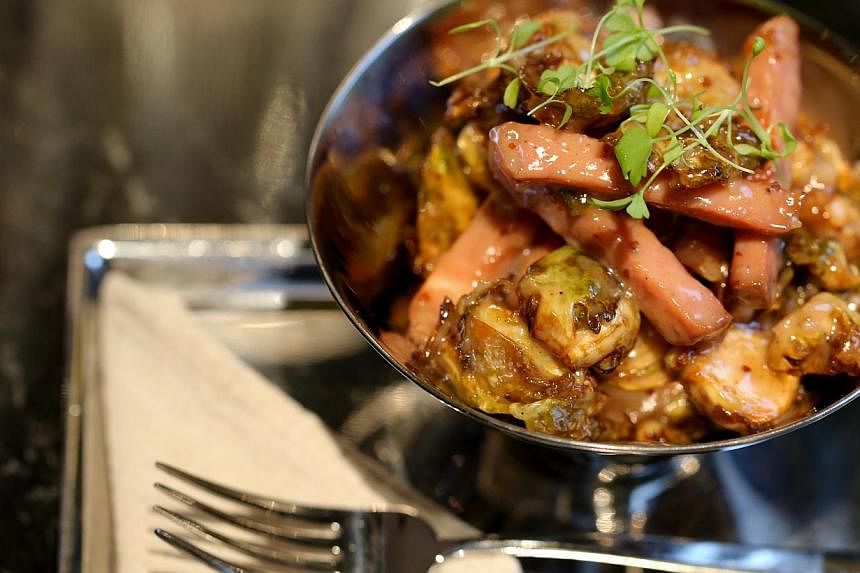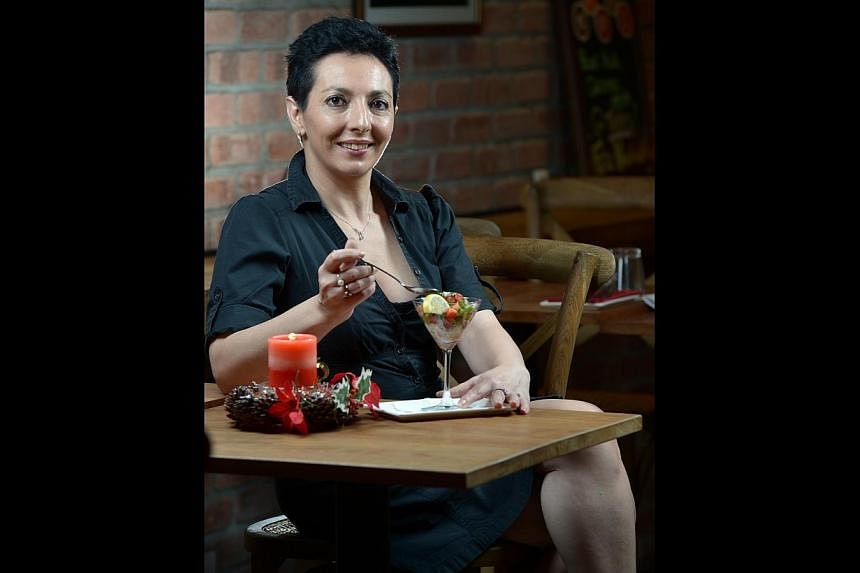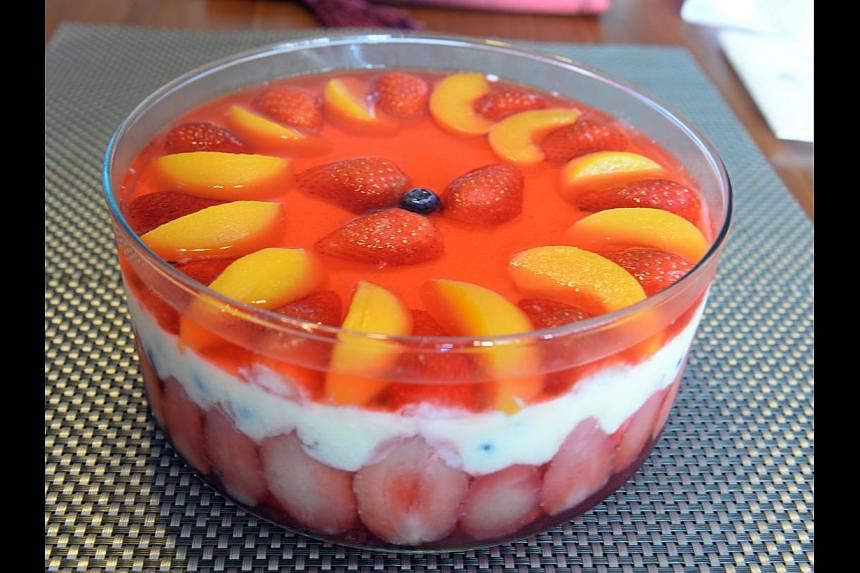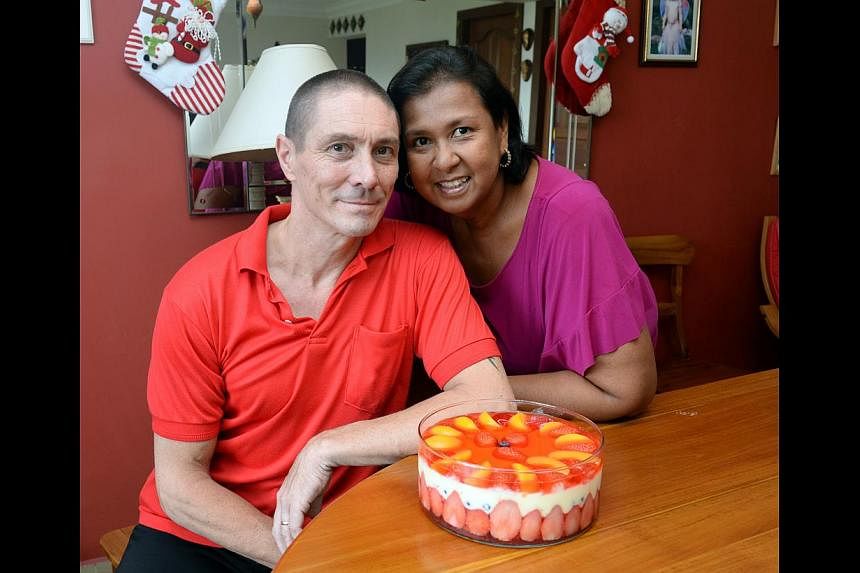PASTA: LINGUINE ALLE VONGOLE
Seafood and pasta are Christmas must-haves for Mr Giovanni Viterale, 49.
The general manager of The Fullerton Heritage precinct, which comprises developments such as The Fullerton Hotel Singapore and The Fullerton Bay Hotel Singapore, is from the Amalfi Coast in the south of Italy, where eating clams during Christmas is a tradition.
He shares his recipe for Linguine Alle Vongole, or linguine tossed with clams in a white wine sauce.
He and his wife Sophie, 44, a housewife, usually throw a Christmas Eve dinner party for eight to 10 people. The meal includes an antipasti and other dishes such as roast duck and his speciality, Linguine Alle Vongole. The couple have two children, Antoine, 18, and Noemie, 15.
Mr Viterale says: "Christmas is all about family and love. It is a time for everyone to draw closer to one another."
INGREDIENTS
For garlic chips:
10 cloves of garlic, peeled and sliced, add more if desired
Olive oil for frying
For pasta:
Salt
50ml olive oil
640g dried linguine pasta
240ml olive oil
24 cloves of garlic, peeled and sliced
8 large red chillies, sliced
24g fresh basil, chopped
About 100 live clams, available from seafood shops and supermarkets
400ml dry white wine
Salt and pepper to taste
80ml extra virgin olive oil
Chilli oil to taste
24g flat-leaf parsley, chopped
METHOD
For garlic chips:
1. Heat a pan of olive oil on medium heat and fry the garlic until golden brown and crisp. Drain on paper towels and set aside.
For pasta dish:
1. Bring a pot of salted water to a boil. Add the 50 ml of olive oil. Add linguine and cook until al dente.
2. Meanwhile, heat the 240ml of olive oil in a large pan on high heat. Fry the garlic until aromatic, then add sliced chilli, chopped basil and clams. Add white wine and cover the pan for about five minutes, or until the clams are cooked and have opened.
3. Blanch the linguine if it has been cooked and drained earlier. If it is just al dente and still in the pot of water, use a pair of tongs to transfer the pasta to the pan.
4. Toss the linguine until it is well coated with the sauce and it absorbs some of the juice from the clams.
5. Season with salt and pepper, drizzle with extra virgin olive oil and chilli oil to taste. Toss quickly and sprinkle with chopped flat-leaf parsley and fried garlic chips to serve.
Serves eight.
Note: If your pan is too small, consider cooking the pasta in several batches. Divide the quantities accordingly.
Rebecca Lynne Tan
GINGERBREAD COOKIES
For Artisan Boulangerie Co's French- German executive chef Eran Mayer, 43, the iconic gingerbread man is a part of his childhood that he shares with his two daughters, aged 10 and four.
He shows SundayLife! a storybook, Le Bonhomme de Pain d'Epice (The Gingerbread Man), along with a green gingerbread man cookie cutter from home that he uses to bake with his girls. The book tells the story of an elderly couple who create a gingerbread man, but it comes to life and runs away, only to get eaten up by a greedy fox in the end.
The cookies, spiced with cinnamon and freshly grated ginger, are part of the holiday tradition for chef Mayer, who speaks fondly of the "joy, flavours and smells" associated with Christmas.
It is also the busiest season for bakers like him, and he turns out all kinds of festive bakes for his seven outlets, including Killiney Road, Great World City and VivoCity.
Reminiscing about Christmas back in Paris, he says: "During this wintry period, it is the bakery's tradition to give customers a glass of hot wine and spiced cookies once a week. We don't do that here, but there is still the spirit of being together and having family meals."
INGREDIENTS
250g butter, softened at room temperature
250g white sugar
1/2 tsp salt
250g golden syrup
1 egg
500g flour
1/2 baking soda
1/2 baking powder
1 tsp freshly grated ginger or powdered ginger
1 tsp powdered cinnamon
Royal icing or melted chocolate (optional for decoration)
METHOD
1. In an electric mixer, cream the butter and sugar for a few minutes until pale and fluffy. Whisk in the salt and golden syrup, followed by the egg until you get a smooth mixture.
2. In a separate bowl, mix the flour, baking soda, baking powder, ginger and cinnamon. Add these dry ingredients into the butter mixture from step 1. The mixture should form a smooth dough.
3. Wrap the dough in cling wrap. Chill it in the refrigerator for at least 1 hour or until firm.
4. When ready to bake, preheat the oven to 180 deg C.
5. Remove the cling wrap from the dough. With a rolling pin, roll out the dough to about 5mm thick on a floured surface.
6. Cut out the shapes with a gingerbread man cookie cutter. Place each gingerbread man on a baking sheet lined with baking paper. Ensure that there is about 3cm space between each cookie.
7. Bake the cookies for 10 to 12 minutes or until they are firm and the edges start to darken.
8. Leave the cookies on a wire rack to cool completely before decorating with royal icing or melted chocolate.
Makes 1kg of cookies, about 30 to 50 cookies depending on the size of the gingerbread men.
Eunice Quek
BRANDY TRIFLE
England-born, Australia-raised Peter Robertson, 52, had been eating trifle for years, mostly on Sundays for dessert after his family's roast dinners.
But his mother's trifles were never very memorable, he says.
In fact, the trifle that the main instructor and owner of martial arts studio ZDK Elite Fitness in Aljunied has become more accustomed to is that made by his wife, Singaporean-Eurasian Veronica Zuzarte- Robertson, 52, a partner in a PR consultancy firm.
They have been married for five years and have no children together.
"It's better than my mum's," he says of her trifle.
Mrs Zuzarte-Robertson says trifles are easy to make and are great for parties, adding that the alcohol in it is a bonus.
Ginger beer or ginger ale can be used in place of brandy.
Her family, who are Eurasian of Portuguese descent, will be tucking into her signature brandy trifle for Christmas this year, along with her family's other traditional desserts, including tarts, and cups of hot cocoa.
INGREDIENTS
1 long vanilla Swiss roll or any sponge cake
15 strawberries, washed, dried and halved
One 825g can of halved peaches in syrup
150ml brandy, or more to taste
125g blueberries, washed and dried
1 litre full-cream milk
6 heaped Tbs custard powder
4 Tbs sugar
2 85g sachets strawberry jelly crystals
2 cups hot water
2 cups icy cold water
To serve:
Evaporated milk
Pouring cream
METHOD
1. Cut the Swiss roll into slices about 2 to 3cm-thick.
2. Line the bottom of a glass bowl with a flat base (about 20 to 25cm in diameter) with the slices of cake. Pack them in tightly, making sure there are no gaps. Place about 15 strawberry halves along the sides of the bowl, wedged between the slices of cake to keep them in place. Reserve the remaining strawberries to decorate the trifle.
3. Drain peaches from the syrup. Weigh out 350g of the syrup and add 3 Tbs of brandy to it and stir. Refrigerate. Cut each peach half into four.
4. Remove the brandied syrup from fridge and add remaining brandy, or more to taste. Stir. Pour the syrup over the cake base, enough to ensure that each slice is well soaked. Layer the peaches on the cake, reserving some to decorate the top of the trifle.
5. Make the first batch of jelly. Place the jelly crystals in a clean, heat-proof bowl. Add one cup of hot water and stir continuously until the crystals dissolve. Add one cup of cold water and stir until well combined.
6. Pour the jelly mixture over fruit and cake. Place bowl in freezer for 1 hour to set.
7. Meanwhile, make the custard. Measure 1/2 cup of the milk and set it aside. Pour the remaining milk into a saucepan over medium heat.
8. In a clean bowl, mix custard powder and sugar until well combined. Add the 1/2 cup of milk and stir well.
9. When the milk in the saucepan begins to boil, add some to the custard powder mixture and mix until it dissolves.
10. Add the custard powder mixture to the saucepan of milk and stir continuously over medium heat for five to six minutes, or until custard thickens.
11. Remove from heat and leave to cool for about five minutes.
12. Remove the trifle bowl from the freezer. Gently spoon the cooled custard over the layer of jelly. Drizzle a little more brandy over the custard if you like.
13. Scatter the blueberries onto the layer of custard. Do not worry if they sink.
14. Place the bowl in the refrigerator to set for at least four to five hours, or overnight.
15. Place the remaining fruit on the custard.
16. Prepare the second packet of jelly by repeating Step 5.
17. Gently pour the jelly mixture over the back of a spoon onto the trifle, being careful to keep the fruit in place.
18. Place the bowl in the fridge to set for at least another five hours, or overnight.
19. Serve cold, with cream or evaporated milk on the side. Keep brandy handy for those who like their trifle with a bit more kick.
Serves eight to 10.
Rebecca Lynne Tan
PICADILLO DE PULPO (OCTOPUS SALAD)
Seafood dishes are never missing from the Christmas family feasts of Ms Maria Sevillano, 47, chef-director of My Little Spanish Place in Bukit Timah Road and My Little Tapas Bar in Club Street.
One of the must-have dishes is a seafood appetiser of octopus salad with Christmas colours from the red and green capsicums. Octopus can be replaced with prawns, squid, mussels and clams, or a mix of all the seafood.
Back home in Salamanca, north-western Spain, her family's dinner feast for about 20 people starts at 10pm on Christmas Eve, and can easily last for three hours. On Christmas Day, traditional dishes on the dinner table include cold cuts, white asparagus with mayonnaise, suckling pig and baby lamb.
This year, however, she will be spending Christmas and New Year's Day in Vancouver, Canada, where her two children, aged 23 and 20, are studying.
She says: "It doesn't matter where we are, there's still the spirit of Christmas and I'm sure my children will request their favourite dishes.
"But there's no Christmas without seafood."
PICADILLO DE PULPO (OCTOPUS SALAD)
INGREDIENTS
3 cloves garlic
1 bay leaf
300g octopus, tentacles preferred
3 red onions, diced
2 green capsicums, seeds removed and diced
1 red capsicum, seeds removed and diced
6 tomatoes, seeds removed and diced
Salt and pepper to taste
135ml extra virgin olive oil
3 Tbs sherry vinegar or white wine vinegar
Lemon slices
METHOD
1. Bring a pot of salted water to a boil with the garlic cloves and bay leaf.
2. Holding the octopus with a pair of tongs, plunge it into the water for 2 minutes and remove. Repeat this two more times. Then, cook the octopus in the water for 45 minutes. Alternatively, you can buy cooked octopus from Japanese supermarkets or takeaway sushi counters.
3. Thinly slice the octopus.
4. In a bowl, mix it with the diced vegetables. Season with salt and pepper.
5. Pour the olive oil and vinegar into a small bottle. Close the bottle cap and shake the bottle vigorously to emulsify the olive oil and vinegar for the dressing.
6. Drizzle the dressing over the octopus and vegetables, and mix well. Set aside in the refrigerator until serving time.
7. Plate the salad in martini glasses or small bowls, with a slice of lemon.
Serves 6
Eunice Quek
GLAZED HAM HOCK & ROAST CROWN OF LAMB
Meat always takes centre stage at the Huber family's annual family Christmas Eve dinner.
There is either roast beef or roast pork, or a roast goose, duck or turkey. There can be ham, lamb or roast quail too.
The family changes the offerings each year for variety.
Mr Ernst Huber, 67, is originally from Switzerland, just outside the city of Zurich. He runs Huber's Butchery, a meat supplier with a retail butchery and grocery shop in Dempsey Hill, with his two sons Ryan, 36, and Andre, 34. Ernst is married to housewife Dorothy, also 67, who is Singaporean Chinese.
In the past, he used to do the roasting and cooking, but these days, Ryan, who learnt to roast meats when he was a teenager, has taken over.
The family's Christmas dinner now includes Ryan and Andre's spouses, and their growing families.
Ryan and his wife Joann, 34, a housewife, have a son who is almost two, and another son on the way. Andre and his wife Belinda, 32, who co-owns an online baby clothing shop, have two daughters aged 20 months and three months.
GLAZED HAM HOCK
INGREDIENTS
2 hind pork knuckles, skin on (1.2 to 1.5kg each)
For brining solution:
About 2 litres of water
100g curing salt (available at Huber's Butchery)
10 cloves of garlic, peeled
10 juniper berries
20g black peppercorns
50g honey
For cooking and glazing:
Water (for boiling the pork knuckles)
Juice, such as apple juice (optional)
200g honey
80 to 100 cloves
METHOD
Brining:
1. Bring the water to the boil in a large pot. Remove from heat and add the salt, garlic, juniper berries, black peppercorns and honey. Stir until the honey and salt dissolve. Leave to cool and refrigerate overnight.
2. The next day, put the pork knuckles into an air-tight container. If you do not have one large enough, use two separate ones. Pour the brining solution over the knuckles. Make sure that they are fully submerged. Seal the container and refrigerate for seven days.
Cooking and glazing:
1. After seven days, remove the pork knuckles from the brine.
2. Submerge them fully in a pot of water and simmer for six to eight hours at about 90 deg C. You can also add juice to the simmering solution to give more flavour to the pork knuckles.
3. When they are cooked and have softened, remove from heat. Leave to cool for 10 minutes.
4. Using a sharp knife, remove the skin, keeping as much of the fat on the meat as possible.
5. Score the fat in a diamond pattern. Cuts should be about 5mm deep.
6. Preheat oven to 220 deg C for 15 minutes.
7. While the oven is heating up, brush honey all over the pork knuckles. Set remaining honey aside. Insert cloves into the corners of the diamond-scored fat.
8. Turn down the temperature of the oven to 200 deg C. Place pork knuckles in the oven for 10 minutes.
9. Remove from oven, glaze with more honey, then return to oven for another 10 minutes. Repeat until the fat begins to melt, some edges begin to char, and a shiny, deep orange colour is achieved.
10. Cool for 10 minutes before carving.
Serves eight, with other dishes. Recipe can be halved.
ROAST LAMB CROWN
INGREDIENTS
2 racks of lamb, about 700g each
10g fresh rosemary
10g fresh thyme
5 cloves of garlic, peeled and sliced
2 Tbs olive oil
Salt and pepper to taste
Other items:
Butcher's twine
Butcher's needle
Aluminium foil
METHOD
1. Place the lamb rack on a cutting board and make slits on the underside of the rack, between each of the rib bones. This is to help the rack bend into crown later on.
2. In a hot pan, heat olive oil, rosemary, thyme and sliced garlic for about three minutes. Sear the lamb racks on all sides. Remove from heat and season with salt and pepper. Set aside garlic and herbs from pan for garnishing.
3. To tie the rack into a crown, place them on an oven tray with the bones pointing to the ceiling and the slits facing outwards. Tie the racks together with twine, using a needle if necessary. Secure with additional twine if necessary. Place a ball of aluminium foil in the centre of the crown to keep the round shape intact. To keep the tips of the bones from burning, wrap each one with aluminium foil.
4. To roast, preheat oven to 200 deg C for 15 minutes.
5. Turn down the temperature to 170 deg C, then roast the lamb crown for 25 minutes. Let it rest for 10 minutes before carving. To serve, drizzle with the herbs and garlic which had been set aside earlier.
Serves eight with other dishes
Rebecca Lynne Tan
BAKED PROSCIUTTO-WRAPPED DATES AND A SIDE OF CRISPY BRUSSELS SPROUTS IN A WARM BACON-MUSTARD VINAIGRETTE
Brussels sprouts are commonly served during the autumn and winter months in temperate climates.
And for Michigan-born American chef Nicholas Trosien, 29, they always made an appearance at Christmas meals.
They were often boiled, bland, and not very appetising, he recalls.
To jazz up the vegetable, the head chef of Manhattan bar at The Regent Singapore in Cuscaden Road has created a recipe of crispy Brussels sprouts in warm bacon- mustard vinaigrette.
He also shares a recipe for baked prosciutto-wrapped dates stuffed with blue cheese, which he says makes for good pre-dinner fingerfood.
It is similar to what his maternal side of the family, who are of Maltese descent, would start their Christmas meal with, stuffed dates or figs.
The chef and his wife, Carmen, 27, a hotel reservations officer, will be spending their first Christmas in Singapore this year.
BAKED PROSCIUTTO-WRAPPED DATES
INGREDIENTS
340g dates, about 18 to 20 pieces
200g blue cheese, crumbled
10 to 12 slices of thinly shaved prosciutto, cut in half lengthwise
1 pack frozen filo pastry
5 Tbs clarified butter for brushing pastry and for frying
Honey to serve
METHOD
1. Cut a deep slit into the dates lengthwise to remove the pits and create a pocket.
2. Stuff each date with blue cheese.
3. Wrap each date with the prosciutto, making sure the ends overlap.
4. Cut the sheets of filo pastry so they are the same width as the prosciutto, and long enough to wrap each date with a little extra to make sure the ends overlap.
5. Brush each strip of filo pastry with clarified butter. Then wrap each prosciutto- wrapped date with the filo pastry. The side that has been brushed with butter should be in contact with the ham. Tuck the sides in, making sure that date is completely surrounded with the dough. Repeat for all the dates.
6. Preheat oven to 170 deg. C.
7. Meanwhile, in a pan over medium heat, brown the stuffed dates in 1 to 2 Tbs of clarified butter.
8. Place stuffed dates onto a baking tray and finish in oven for about 5 to 7 minutes.
9. Serve with a drizzle of your favourite honey.
Serves eight, makes about 20 dates.
CRISPY BRUSSELS SPROUTS IN WARM BACON-MUSTARD VINAIGRETTE
INGREDIENTS
For the mustard vinaigrette:
2 Tbs Dijon mustard
1 Tbs wholegrain mustard
1 Tbs shallots, chopped
1/2 Tbs minced garlic
1 tsp fresh thyme, stem removed, chopped
4 Tbs red wine vinegar
1 Tbs sugar
Salt to taste
Pepper to taste
2/3 cup vegetable oil
2 Tbs water to adjust consistency, if necessary
Other ingredients
1kg Brussels sprouts
Vegetable oil for deep-frying
300g bacon
50g garlic, finely chopped
120ml red wine vinegar
55g raw granulated sugar
60ml mustard vinaigrette (recipe above)
METHOD
For the mustard vinaigrette:
1. Add all the ingredients, except the oil and the water, into a blender and blend on low to medium speed. While blending, slowly pour oil in a slow and steady stream to emulsify the vinaigrette. If the vinaigrette is too thick, add water to adjust the consistency.
For brussels sprouts:
1. Cut each sprout in half lengthwise. Remove outer leaves and blanch in boiling water. Strain and shock in an ice bath to stop them from over cooking.
2. Remove from ice bath and dry the Brussels sprouts on paper towels.
3. In saucepan of hot oil, or in a deep-fryer, cook the sprouts until golden brown and crisp. Drain on paper towels. For a healthier alternative, drizzle sprouts with a little oil and roast on a tray in an oven for 17 to 20 minutes at 195 deg C, until the leaves have some char.
4. Meanwhile, cut the bacon into pieces about 2.5cm wide. Then, fry the bacon strips in a separate pan on medium heat. Allow the fat from the bacon to render. This will take five to seven minutes.
5. Add minced garlic and cook for two minutes. Add red wine vinegar and sugar, stir to dissolve sugar and reduce vinegar.
6. Turn off the heat and add 60ml of mustard vinaigrette to the pan. Stir to emulsify the vinaigrette with the rendered fat and vinegar. Taste and season with salt and pepper if necessary.
7. Add sprouts to the pan. Toss to coat. Serve.
Serves eight.
Rebecca Lynne Tan












